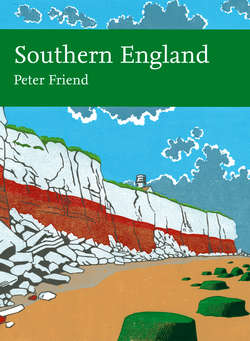Читать книгу Southern England - Peter Friend - Страница 8
CHAPTER 1 Looking at Southern England’s Landscapes FIRST APPROACHES
ОглавлениеTHE WORD LANDSCAPE has different meanings for different people, and the best way to illustrate the meaning I have adopted in this book is to look at an example. I have chosen a landscape in the northwest corner of Norfolk, part of our East Anglia Region (Fig. 1).
FIG 1. Landscape of the northwest corner of Norfolk. (Copyright Norfolk Museums and Archaeology Service & Derek A. Edwards)
My approach is to focus first on the natural features that we can call landforms, because they have distinctive shapes that directly reflect the processes that formed them. In this Norfolk landscape, coastline landforms are clearly defined but are remarkably varied, ranging from sea cliffs to sandy beaches, gravel spits, wind-blown dunes and salt marshes. Inland, the main features in this photo are the groups of buildings that form the villages and the edge of the town of Hunstanton, and the pattern of fields and woods. All of these are man-made features and are best understood by following the work of landscape historians. My interest is primarily in the natural topography on which these man-made features have developed, because even in this rather flat landscape – and not clearly visible on the photograph – there are gentle hills, valleys and streams that I want to try to understand.
Scale and size in landscapes are important considerations that we will return to frequently. The landscapes that we shall be discussing are generally kilometres to tens of kilometres across, and they are often best examined from the air, or by using computer-based maps with exaggerated vertical scale.
Southern England contains many famous and well-loved natural landscapes, ranging from the Chalk Downs, with their unique flora and fauna, to the rocky promontories and bays of Cornwall, Devon and Dorset. In total topographic contrast, the Fens of East Anglia are regarded by some as representing an extreme absence of any scenery at all, but their remarkable flatness is of interest because they are the result of recent sea-level rise, and of engineering on a remarkable scale. These different landscapes are produced by a wide variety of events and processes; exploring these is the theme of this book.
As we have already seen, landscapes have often been extensively modified by people. The early clearance of woodland and the construction of field boundaries have profoundly changed the scenery and, more recently, the construction of buildings, roads, railways, canals and airports has almost completely covered some areas of Southern England. Figure 2 shows night-time lighting in cities, towns and oil platforms, giving a vivid impression of the present extent and distribution of the larger settlements. It is surprising how varied the population density is, even in crowded Britain. Using the figures for 2002, the population density of the UK overall is 244 people per square kilometre, but this conceals a huge variation: 8 people per square kilometre in the Highland Region of Scotland, 143 for Cornwall, 149 for Norfolk and an amazing 13,609 for Kensington and Chelsea in London.
The main focus of this book is the pattern of large scenic features that have resulted from natural episodes that predate human influence. It is not usually difficult to distinguish the natural from the man-made, and the study of the natural can often explain many aspects of the way our ancestors lived in the landscape. It is possible to uncover the reasons why people have chosen to settle with their families in certain places, why villages have grown by the clustering of houses in particular locations, and why some villages have then grown further and turned into towns and eventually cities. Even the roads, railways and airfields have clearly grown using the valley floors, river crossings, better-drained slopes and plateaus that are part of the natural scenery.
FIG 2. Satellite image over Britain showing artificial lighting at night. (Copyright Planetary Visions Ltd/Science Photo Library)
There is a further enjoyment that people find in landscapes and scenery that is more difficult to understand. Is it just the physical challenge that causes people to walk and climb to the tops of hills, mountains and other viewpoints? Why do people enjoy the work of landscape painters and photographers? Why do so many tourists in cars choose to take ‘scenic’ excursions rather than the shortest routes, and why is the preservation of ‘unspoilt’ or wilderness areas now such a popular cause? It is difficult to understand the various emotions involved, and trying too hard to analyse them may be missing the point. So it seems best to hope simply that this book will help to satisfy some people’s curiosity, and at the same time add to their enjoyment of our natural landscapes.
